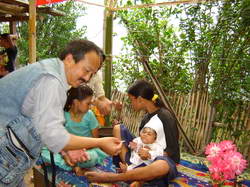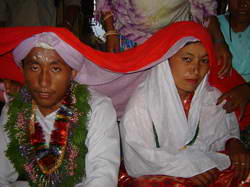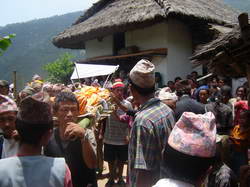The word Athpahariya is not derived from the native language spoken by the people of this folk group;
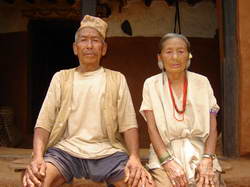 rather
its derivation is related to the Nepali compound word Athpahar, involving Ath
(which means ‘eight in number’) and Pahar (meaning ‘the time period of 3
hours’). Since eight Pahars equal 24 hours, Athpahariya means ‘the person who
dedicates himself in working for twenty four hours’. In the past, particularly
the kings’ body guards were the persons having such a duty to fulfill; therefore
it is said that people belonging to a particular section of Rai community who
were deputed as the kings’ body guards were entitled Athpahariyas.
rather
its derivation is related to the Nepali compound word Athpahar, involving Ath
(which means ‘eight in number’) and Pahar (meaning ‘the time period of 3
hours’). Since eight Pahars equal 24 hours, Athpahariya means ‘the person who
dedicates himself in working for twenty four hours’. In the past, particularly
the kings’ body guards were the persons having such a duty to fulfill; therefore
it is said that people belonging to a particular section of Rai community who
were deputed as the kings’ body guards were entitled Athpahariyas.But there are debates regarding who were the kings these people had served as Athpahariyas.
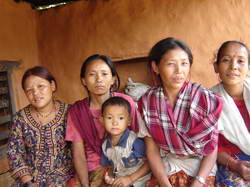 In
one document published by the government, it is said that after taking control
over the far-eastern Kirant kingdom, king Prithvi Narayan Shah had deputed the
people of this ethnic group in the post of Security Guard, for the protection of
Dhankuta Khalangakot; so they were called the Athpahariyas. In another folk
etymological explanation, it has been said that the Athpahariya folk group was
developed from the eight families of eight surnames (in Nepali Ath Pariwar) of
the Rai community who used to live in and around Dhankuta region from time
immemorial. In their Mundum (oral Veda), Athpahariya people still mention the
kingdom of Margahang, which was located within the border points of
Mudhe-Guranshe in the north, Tamor river in the south, Tankhuwa rivulet in the
east and Uttarpani-Marga Pokhari in the west. Athpahariyas say that they are the
descendants of the security force who were deployed to protect this Margahang
kingdom.
In
one document published by the government, it is said that after taking control
over the far-eastern Kirant kingdom, king Prithvi Narayan Shah had deputed the
people of this ethnic group in the post of Security Guard, for the protection of
Dhankuta Khalangakot; so they were called the Athpahariyas. In another folk
etymological explanation, it has been said that the Athpahariya folk group was
developed from the eight families of eight surnames (in Nepali Ath Pariwar) of
the Rai community who used to live in and around Dhankuta region from time
immemorial. In their Mundum (oral Veda), Athpahariya people still mention the
kingdom of Margahang, which was located within the border points of
Mudhe-Guranshe in the north, Tamor river in the south, Tankhuwa rivulet in the
east and Uttarpani-Marga Pokhari in the west. Athpahariyas say that they are the
descendants of the security force who were deployed to protect this Margahang
kingdom.Settlement and Population
Presently, Athpahariya Rais are residing in the different places of Dhankuta Municipality including
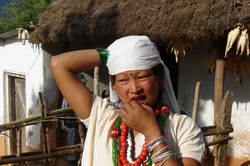 Dadagaun,
Chharagaun, Sipting, Pangsing, Tekunala, Santang, Karmitar, Thoka, etc., and in
Belahara and Bhirgaun VDCs of Dhankuta district. To cover the entire settlement
of this folk group, the borders of the settlement area include: Hatikharka and
Sanne VDCs to the north, Tamor river to the south, Tankhuwa VDC to the east, and
Akhisalla VDC to the west. Topographically, these localities are in the altitude
of 300 to 2000 metres above the sea level, where most of the landscape remains
hillside. Within the geographical boundaries just mentioned, there are some
small rivulets including Tankhuwa Khola, Madhu Khola, Nibuwa Khola, Bakhre Khola,
Patle Khola, Ruduwa Khola, and Phongsuwa Khola. Besides, there is Tamor river to
the south.
Dadagaun,
Chharagaun, Sipting, Pangsing, Tekunala, Santang, Karmitar, Thoka, etc., and in
Belahara and Bhirgaun VDCs of Dhankuta district. To cover the entire settlement
of this folk group, the borders of the settlement area include: Hatikharka and
Sanne VDCs to the north, Tamor river to the south, Tankhuwa VDC to the east, and
Akhisalla VDC to the west. Topographically, these localities are in the altitude
of 300 to 2000 metres above the sea level, where most of the landscape remains
hillside. Within the geographical boundaries just mentioned, there are some
small rivulets including Tankhuwa Khola, Madhu Khola, Nibuwa Khola, Bakhre Khola,
Patle Khola, Ruduwa Khola, and Phongsuwa Khola. Besides, there is Tamor river to
the south.According to the household survey carried out by Athpahariya Kirant Rai Samaj in 2061 B.S., there are altogether 1442 households of this folk group in their entire settlement area, with the total population of 7405.
House Construction and Use
Most of the houses in the settlement of Athpahariya Rais are found in dispersed pattern; but in some places they are also in semi-compact
 pattern.
To consider the architecture design, construction materials and the folk belief
regarding the use of house, their houses are a bit different from the other
groups of Rai community. In this folk group’s original tradition, the ground
floor is always square sized, and the roof also has 4 sides. From the point of
view of use their houses can be classified into three types: a) Thenapang, the
religious house, b) Derapang, cultural house, and c) Pangi, for day-to-day use.
pattern.
To consider the architecture design, construction materials and the folk belief
regarding the use of house, their houses are a bit different from the other
groups of Rai community. In this folk group’s original tradition, the ground
floor is always square sized, and the roof also has 4 sides. From the point of
view of use their houses can be classified into three types: a) Thenapang, the
religious house, b) Derapang, cultural house, and c) Pangi, for day-to-day use.Athpahariya Language
This language belongs to the Tibeto-Burman language family, and grouped under the Kiranti sub-branch of the family. Till now, it has not been used in the electronic media, nor in any specialized functions such as education, office or press. So far, except for the recent initiatives to prepare the Athpahariya Dictionary, Athpahariya Grammar and the written newspaper Phungning, no published material is available in the medium of their language. So, its use is limited to folk communication alone, for purpose of conversation among the people of Athpahariya Rai community. But there are some studies on the language and culture of this folk group.
To explore the linguistic features of this language a bit further, altogether 5 vowels and 21 consonant sounds have been identified in it. In the initiation of the researchers of FOFO study project and the local experts of Athpahariya Kirant Rai Samaj, a basic dictionary of Athpahariya language has been prepared, which has covered the vocabulary in several areas including: plant/siblings, fruit items, flowers, vegetables, food grains, human body organs, birds’ and animals’ names and their organs, meat varieties, weapons and tools, dress items, ornaments, musical instruments, handicraft work, kinship, terms related to jand-raksi (local beer and alcohol), cultural vocabulary, pronouns, different types of adjectives, verbs, adverbs, conjunctions, child vocabulary, etc.
After a discussion between the FOFO project researchers and the members of Athpahariya Kirant Rai Samaj, the work of standardization of this language has just begun, along with the beginning of writing it. But the language does not have its own script; so Devanagari script has been adopted in these works. Some variations have been found this language spoken in the different areas of the folk group’s settlement. But the language spoken in the 7th, 8th and 9th wards of Dhankuta municipality has been followed as the norm for the standardization process.
Family and Kinship
Athpahariya Rais have the practice of living in both the nuclear and joint families. In the nuclear family,
 there
are two generations of people, whereas a joint family has three or more
generations living together by sharing the same house and kitchen. Normally the
son does not get separated immediately after his marriage. But after the
marriage of his younger brother, he may wish to live separately. At the time of
separation, the parental property is divided equally between the parents and
sons.
there
are two generations of people, whereas a joint family has three or more
generations living together by sharing the same house and kitchen. Normally the
son does not get separated immediately after his marriage. But after the
marriage of his younger brother, he may wish to live separately. At the time of
separation, the parental property is divided equally between the parents and
sons.Mainly three forms of kinship are found among Athpahariyas: i) kinship by blood; e.g. brother and sister, ii) kinship by marriage; e.g. father-in-law, sister-in-law, etc., iii) kinship by social relation; e.g. Miteri (friendship bond established after a special ritual) relation.
Kinship behaviour varies according to the status of the kin. Some relatives are more respectable than others, while some are in ‘joking relation’. For instance, father, mother, uncle and aunt are respectable, but solti-soltinee, sali-bhena, anuga-nakma, matengba-matengma etc. are all in joking relation. In this folk community, son-in-law and daughter-in-law are treated equally as the son or daughter of the family. Agumba has a vital role in the kinship system among Athpahariya Rais; and in his absence, they do not want to observe the auspicious celebrations/rituals like the first rice-feeding ceremony, first hair cutting ceremony and marriage ceremony.
Folk Belief
People in this folk group believe that one should always speak the truth, and should not scold or curse anybody. Anyone involved in such ‘banned’ acts will be considered the culprit and will be punished. As a punishment, the person should offer Bhakal (special offering to the folk gods/goddesses, especially animals). According to their belief, no Athpahariya Rai should migrate to a place beyond Sanguri Dada (the hilltop bordering Dhankuta and Sunsari districts). Except for the people belonging to Athpahariya Rai group, no stranger should touch the Mul Khamba (the main pillar of the house), because that is the place of their ancestors.
Folk Gods/Goddesses
In this folk group, people worship Jimi, Marga Tinkille, and Hang Thalo. These are the special
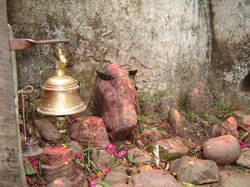 places where Athpahariya gods/goddesses called Jimihang, Margahang, Hangma Rani,
Shreemarga, etc. are kept. There are 2 Margas in Sipting, 1st at Bihibare Haat,
2nd at Pangsing. Besides, there are Shreepanchami Marga, Khawaduk Marga, Phokim
Marga, Umreuli Marga, etc. Jimi Thans (places where Jimi is worshipped) are
located at Adheri, Dhankuta Municipality-7, Phokim Thalo (Dhankuta-7), and
Belahara VDC - 5. Six Tinkille Thans are found in Sipting area, two in
Dhankuta-5 (called Ambirhang and Hangmarani), two in Dhankuta-8 (Hangmarani and
Hangmakcha), one in Khalde, one at Pelekpang, one in Belahara-2 and two in
Belahara-5. In addition, there are altogether 9 Bokrohangs in Belahara.
places where Athpahariya gods/goddesses called Jimihang, Margahang, Hangma Rani,
Shreemarga, etc. are kept. There are 2 Margas in Sipting, 1st at Bihibare Haat,
2nd at Pangsing. Besides, there are Shreepanchami Marga, Khawaduk Marga, Phokim
Marga, Umreuli Marga, etc. Jimi Thans (places where Jimi is worshipped) are
located at Adheri, Dhankuta Municipality-7, Phokim Thalo (Dhankuta-7), and
Belahara VDC - 5. Six Tinkille Thans are found in Sipting area, two in
Dhankuta-5 (called Ambirhang and Hangmarani), two in Dhankuta-8 (Hangmarani and
Hangmakcha), one in Khalde, one at Pelekpang, one in Belahara-2 and two in
Belahara-5. In addition, there are altogether 9 Bokrohangs in Belahara.Folk Festivals
The main festivals celebrated in this folk group are: Baishakhe (Bisu), Bhadaure (Chamanwagi),
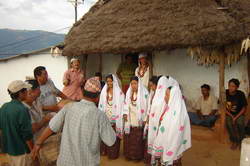 Mangshire
(Wadangmi), etc. Baishakhe is celebrated in the month of Baishakh (April-May),
when the cultivation season starts. People in this folk group worship Jimi-Bhumi
(god of the land) as their god on this occasion, which symbolizes that they are
giving importance to the contribution of land in their lives.
Mangshire
(Wadangmi), etc. Baishakhe is celebrated in the month of Baishakh (April-May),
when the cultivation season starts. People in this folk group worship Jimi-Bhumi
(god of the land) as their god on this occasion, which symbolizes that they are
giving importance to the contribution of land in their lives.Bhadaure is celebrated during Bhadra (August-September). In this festival, they offer rice-grains of Ghaiya (an indigenous paddy variety) and Jand locally prepared beer) of Pangdur (indigenous millet variety) to their god.
Mangshire is the greatest festival of Athpahariya Rais, celebrated in the month of Mangshir (November-December). On this occasion, the people who have lost their parents within the running year go to the Mangbung Pujari (the folk religious priest) with the cloth items worn by their parents. Then they worship and offer those things to the folk gods as well as their ancestors. Some other rituals performed on this occasion include: Bhejo Lagaune (killing the he-buffalo and distributing its meat), Maruni Nach (a folk dance, in which boys dance in woman’s dress), etc.
Most of the Athpahariya Rais do not celebrate Dashain and Tihar; but those who are Chhitlinge by surname are following some major customs and rituals of Dashain – like growing Jamara and sacrificing animals at Moula (a special place where the folk gods are worshipped).
Folk Dresses and Ornaments
People of the Athpahariya Rai folk group have their own identity in the dresses they wear. Most of their dresses are made of the threads
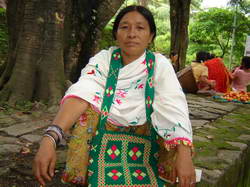 of
cotton which are grown in their own land. Mostly, there is no difference between
the dresses they wear in day-to-day life and those worn on special occasions or
festivals.
of
cotton which are grown in their own land. Mostly, there is no difference between
the dresses they wear in day-to-day life and those worn on special occasions or
festivals.Men in this folk group generally wear Choubandi Lotling (also called daura-suruwal), Thute Suruwal or Kattu (like the underwear), Deudi Bhoto, Bhabat (lagauti) etc. They wear cap on the head. They also wear woolen sweater in winter, which is mostly home-made.
The women wear Mekhli (for covering the upper part of the body), Chhitasim (the under-garment like lungi with black spots on the white background), Takombi (shawl), etc. These dresses are worn when they go to the marketplaces, and during festivals or other special occasions.
Male Athpahariyas do not have any special ornaments; but the women usually decorate their body with various ornamental items. The main items are: clip (on the hair), Nakphuli and Bulaki (on the nose), Tariwan (on ears), Bichkini, Patewa, Hansuli (silver necklace), Chhikima/Reji/Rangchhi (various sorts of beads made of silver coins), etc.
Folk Medical Treatment
There is the practice of curing illness with the help of shaman among Athpahariya Rais. Besides this, the use of folk medical plants is also widespread. The person involved in the treatment of diseases is called Mangkata, Yawa, Janawa, etc. People believe that the folk medical practitioner has known the ways of treatment after his ancestors taught him those methods in the dream. So, these medical practitioners are ready to go to any person suffering from illness and treat them; but they do not want to share their knowledge of treatment with others.
Folk Literature
Athpahariya folklore is rich in folk literature as well. There is a special house constructed for cultural activities in this folk community, called Derapang. Youths in particular gather regularly at Derapang, then start their activities of recreation, which involve the creation and performance of folk literary genres including the singing of folk songs and dances. In this society, the folk creators and performing artists are mostly called by their Phungings (nicknames) derived from the literary genre or performing art in which they are the experts – e.g. one expert in playing the music of Murali (the flute) is called Muralimang, a female singer is called Basanphung, and lady dancer is called Rasan Jethi, etc.
Child song is one of the wonderful examples of Athpahariya folk literature, which is in verge of extinction nowadays. It is sung by adults while trying to make the young child sleep comfortably. The song is the same for both male and female children; however, there is difference in the use of the word to differentiate gender while addressing the child Ba is used for son, and Ma for daughter.
Besides, Mundum song is also an important heritage of Athpahariya folklore. Basically, this song is religious/devotional in nature. Mundum is not only the specimen of folk literature but also the life-philosophy of the entire Kirant community including this folk group. It is found in epic form, which is transmitted orally from generation to generation but not yet written. Athpahariya Rais also have the tradition of forming separate groups for singing this devotional song on some occasions. Such a group works actively during Mangshire festival, and huge singing and dance performances are organized on this occasion.
This folk community has a unique form of singing tradition called Hiya chhamlo, which is not found in other groups of Kiranti community. People believe that this old form of singing is derived from their Mundum. There are two categories of Hiya chhamlo, called Chhiwak and Chhembado. The first one, Chhiwak, is in dialogue form and usually sung between man and woman, which is full of recreation but lacking musical rhythm. When it is sung with the rhythm and melody, Chhiwak is called Chhembado; and it has all the features of folk song.
Folk Performing Arts
Folk dance, folk drama and entertaining folk games are the most important forms of performing arts found among Athpahariya Rais. In folk dance, two are worth mentioning: Dhole Nach and Maruni Nach. Dhole Nach is also called the Mangshire Nach, and usually it is accompanied with Dhole Geet (song which is sung along with the music of Dhol, the folk musical instrument). The Maruni Nach is performed along with the songs that describe the legends and life of Athpahariya kings of the past.
Aathpahariya folk games can be classified into three types: a) games related to children, b) games related to adults and youths, c) games related to the social customs and rituals.
Among the folk games related to children, Chongchinget or Chimusichi, Phesreke or Nangchhiri, Dhukumuku, Gatti, Sinkauli, etc. are the important ones. The youths play the games like Chhelo (throwing the stone), Dandi-biyo (striking a short stick with a longer one), Phalmari (long-jump), etc. Similarly, the games played on the occasion of social customs and rituals include: Baghchal, Dhanu-Ban (bow and arrow), swinging on the rope, Ratyauli, Ulangkhutti Maroti, etc.
Folk Musical Instruments
Some of the musical instruments found in this folk group are: Chyangrumba or Dhol, Chhangchhuppa or Jhyamta, Angom (Binayo), Murchunga, Murali/Bansuri, Mandala (madal), Jhyali, Majira, etc.
To speculate the development of these musical instruments, Dhol is considered the oldest one. Binayo, Murali, Bansuri and others were developed later on. Till now, Athpahariya Rai folk group does not have any musical instrument made of strings and bows. However, it is not clear whether these instruments were extinct from this folk group in the past, or they did not exist at all right from the beginning.
Gender Issues and Decision Making Procedure
Men and women having equal status in the family and community, there is almost no gender discrimination in Athpahariya Rai society. Although man is usually the head of the family, woman’s role is equally important in planning and decision making on domestic matters. The husband decides almost nothing in absence of his wife. They generally discuss to plan the daily activities collectively in the family after dinner; and decision is made thereupon.
After a year of the death of her husband, a widow can wear her casual dresses. There is no restriction for the widow or widower regarding their clothing. They also have the freedom for remarriage; but whether to marry or not depend entirely on the widow’s or widower’s wish. An unmarried adult woman possesses very strong role in the family. She is heard by all.
Male and female members of family share their labour in all sorts of activities. However, a few cases are the exceptions; e.g. cooking meal, which is mostly considered the responsibility of women. But when women are very busy, men take the responsibility of cooking as well. Similarly, though ploughing the field is generally considered the work of men, unmarried girls are also found involved in it to support men in their work.
Rites of the Passage
The major rites and rituals of Athpahariya Rai folk group, from birth to death are briefly described below.
